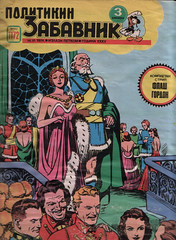by Ostrander, Hall, Lei/McKenna
Dark Horse Comics (November, 2009)

This slim (22 pages) volume based on the script by John Ostrander attempts to provide a somewhat novel perspective of the events from Revenge of the Sith
It looks like one of the main purposes of Seconds to Die is to remind the readers of the iconic portrait of hooded-gorgeous-Anakin-gone-bad from Episode III, which appears at least three times.
The yarn about Sha Koon, the last Jedi that survived the onslaught at the end of Clone Wars and then decided to incite a suicidal duel with Vader would have been interesting if her femininity was not totally inconsequential. She’s depicted as a member of species with a head akin to the Predator (without the cool gear), and her body most resembles a very tall human male. The application of gender mainstreaming in this case means blotting out any gender specifics. This comes as no surprise, as lack of sex has been the staple of the franchise since the Phantom Menace (i.e. the removal of the dynamics between Harrison Ford's Han Solo and Carrie Fisher's Leia).
The final battle is quite lame. The Cthons, “primitive” people who help Sha Koon against Vader have “some useful bits of technology” like an “electroshock net.” However, they first attack the lightsaber-armed Sith lord naked and weaponless, and he cuts them to shreds. The utter absence of projectile weapons, especially firearms, within the Star Wars universe has always seem perplexing, and can only be explained by the notion that these stories remain within the framework of fairy tales for kids that need not develop critical thinking skills.
At the end, the conclusion raises this comics to a new level of lameness. The stabbed Sha Koon has a two-page “flashback”—a vision—with a short recap of the adventures of Luke Skywalker, including the death of the Emperor, and dies “at peace.”
This “comforting” epilogue brings to mind the lucid analysis by David Brin in his legendary essay "Star Wars" despots vs. "Star Trek" populists, objecting to absolving Vader from guilt of destroying billions lives during his career because he showed repentance by not killing his own son.
Fortunately, Seconds to Die is just a one-shot. Even though the technical execution of the script and the drawings by Jim Hall (pencil), Alex Lei, Mark McKenna (ink), and Ronda Pattison (color) is of quite high quality, one can only go so far chewing the cud instead of injecting some logic, or creativity into the stale blood of Star Wars.






